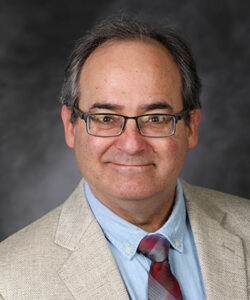President Armacost addresses national conference on campus sexual assault & harassment
UND’s highly effective programs can serve as model, says Armacost, alongside other speakers including U.S. Secretary of Defense
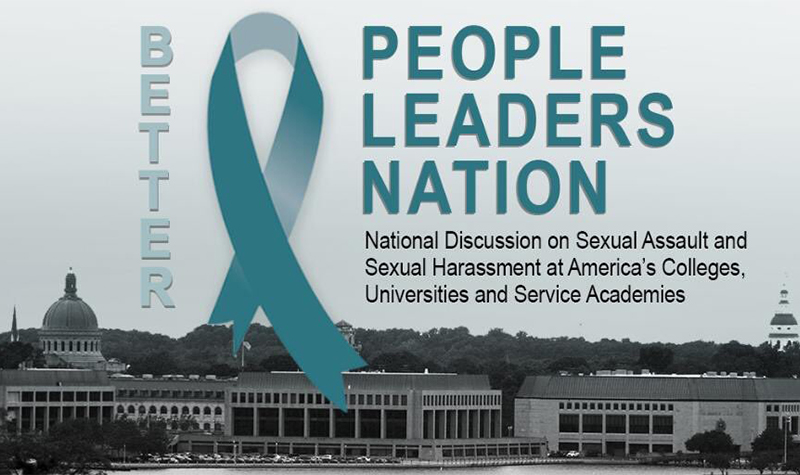
Editor’s note: On Tuesday, UND President Andy Armacost delivered the introductory address for a national Zoom meeting of government, academic and military leaders, the 2021 National Discussion on Sexual Assault and Sexual Harassment at America’s Colleges, Universities and Service Academies.
At the virtual conference, subject matter experts and key stakeholders – including members of Congress, civilian college and university leaders, and Department of Defense and Military Service Academy heads – provided messages, recommendations and strategies to improve responses to incidents of sexual assault and harassment. Speakers included Secretary of Defense Lloyd Austin, Air Force Secretary Frank Kendall III and Adm. Karl Schultz, the commandant of the Coast Guard.
This is the third year of the national discussion, an initiative developed by the Secretary of Defense and the secretaries of the Air Force, Navy, and Army. The conference shows the resolve of the armed services to eradicate sexual assault and sexual harassment at the academies, in ROTC programs across the country and in the ranks of the Army, Navy, Air Force and Marine Corps, conference organizers said.
“Countering sexual assault and harassment is not only a top priority here at the Air Force Academy, but at all of our service academies as well as in our military,” said Air Force Lt. Gen. Richard Clark, the superintendent of the Air Force Academy, in his introductory remarks.
“These are societal issues that unfortunately impact organizations and campuses across the country.” And they’re also leadership issues, which is why the conference recruited as speakers top leaders from around the country – including UND President Armacost, a retired Air Force brigadier general and former dean at the Air Force Academy, Clark said.
President Armacost’s remarks led off the conference. They are reprinted below in a lightly edited transcript, along with a selection of the slides that the president used in his talk.
* * *

Good morning. I’m thrilled to be here today and to join in this important national discussion. It’s also great to be able to rejoin my colleagues at the Air Force Academy this morning and to share information about the important work happening at the University of North Dakota to reduce the incidence of sexual violence and all forms of violence.
Let me begin by thanking Secretary Kendall and Lt. Gen. Clark for hosting this important event. I know the Air Force and its Academy remain steadfast in their commitment to the eradication of sexual violence in our ranks.
Let me also think the entire planning committee for their hard work designing and delivering this important conference, always a challenge during these uncertain COVID times. I appreciate their invitation to speak today.
I am thrilled to see old friends and colleagues today – Kimberly Dickman; Chris Kilmartin; Dom Angiollo; Joe Don Looney; Karen DeAngelis – and so many outstanding speakers and panelists from across the nation.
My bio
I had the privilege of serving 30 years in the Air Force, 20 of which were at the Air Force Academy. I had a front-row seat to what unfolded in the early 2000s, with reports in the Denver independent news weekly, The Westword, about cases of rape and how they were handled, or mis-handled, by Air Force leadership. The first story in 2003; Vanity Fair in 2006; and many stories in between and that followed. The Colorado Springs Gazette and reporter Pam Zubeck, and others, doggedly pursued accountability, and the attention continues to this day, both from the press and from members of Congress.
When I became the Dean of the Faculty in 2013, we had much better systems in place to track cases and to respond. We had robust reporting methods including case tracking and anonymous surveys. We had a response system that evolved to provide better support to survivors of sexual crimes, but nonetheless a system involving human beings and, therefore, imperfect.
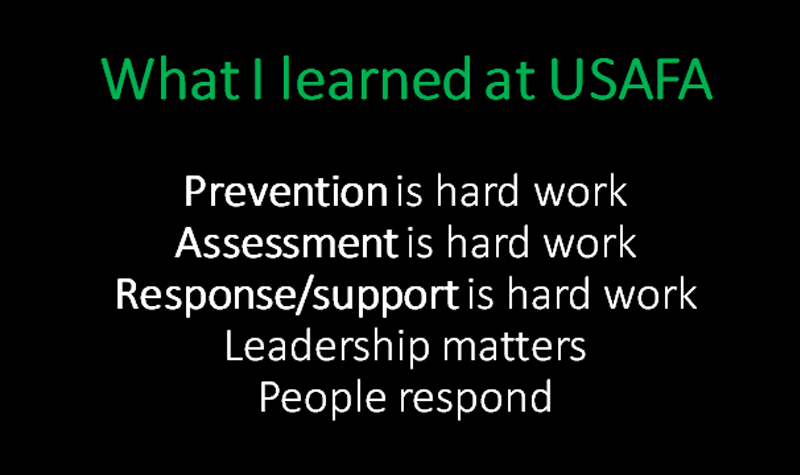
What I learned at USAFA
This work was all-consuming. It is difficult. Never did I imagine the amount of time leaders would spend on individual cases, on committees to track the progress of those cases, and on the continual examination and modification of our prevention and response systems.
Throughout my time, I saw the launch of new programs such as the Officer Development System, SAPR programs, Green Dot, and others. We saw the creation of the Center Character and Leadership Development. I saw the impact of high-profile court cases with outcomes that would suppress subsequent victims of sexual violence from reporting. I saw peer groups among cadets taking sides in cases on a campus that is so tightly connected that there seemed to be few secrets.
I saw the quest for due process that would protect the rights of the accused. As leaders of the institution, we had to be mindful of the impact of our words, both in support of victims of crimes but also for the constitutional protection of due process. Each public statement had to be accurately crafted and timed appropriately. This was hard and tiring work, and I admired those members of our staff who were committed full-time to their work on prevention and response.
After watching the documentary “The Hunting Ground” in 2015, I wondered: how could other universities not take this as seriously as we do? At national conferences, I would hear panel sessions and wonder why other schools didn’t seem to recognize the depths of these problems on their campus. These same concerns led to the creation of this National Discussion series. So, in 2020, when I took the helm of the University of North Dakota, I wondered what I would find … an aggressive program or a blind eye?
What I see at UND
The wonderful news is that we have a University and staff members committed to the prevention and response of sexual violence on our campus. The two co-authors of this presentation, Donna Smith and Alex Pokornowski, are central to this work. They and other key players at UND have devised and delivered highly effective programs.
The purpose of today’s talk is to share what we are doing. But it begins with key principles that are important to how we have been successful and how we have quickly responded to recent changes in Title IX regulations. Let me offer a few key observations about how our team has developed a strong program. I hope these are useful anecdotes as you move forward. Perhaps it opens a conversation between your school and ours.
 Partnerships are key
Partnerships are key
The first is point I must emphasize is the role of formal partnerships. One of our most important relationship is with the Community Violence Intervention Center, located in Grand Forks. Our partnership with CVIC places a full-time prevention advocate on our campus for essential outreach to students and employees. Allison and Claudia offer a variety of educational programs to a wide array of groups on campus, programs that I’ll talk about in particular in a few moments.
The importance of teamwork
In addition to bringing in external partners, a key element of our program is the sense of teamwork across the campus. Our Title IX office, our Office of Student Rights and Responsibilities, the University Police Department, the University Counseling Center, Student Health Services, the Provost’s Office, the Athletic Director, and other offices form the foundation of our Committee on Sexual Violence Prevention and Response. This committee coordinates our university’s response to incidents of sexual violence, focuses on campus culture, and helps us build the close relationships that must exist on a daily basis to work through prevention and response actions and to develop campus-wide policy.
Develop trust
This work is emotionally demanding and relies on a strong sense of trust between each teammate. Trust must be deliberately created, as it can be quickly lost. Each of the university’s players in prevention and response must actively work to sustain their close working relationship, keeping in mind the higher purpose of this important work. Trust must also be nurtured with our students.
Meet the students where they are
A key tenet of this work is to be present with the student body by offering programming that meets them where they are. Our CVIC partners do this exceptionally well with their educational programs. The accessibility of our campus teammates has been extraordinary. And our University Police Department has developed a strong, positive presence in the areas where students live and gather.
Proactive outreach to attorneys
As we evolved our programs and processes, we have found that engaging attorneys on both sides was important as we defined our processes that are responsive to complaints and fair to respondents. The ability of the university to respond to reports of sexual violence demanded a range of perspectives. These perspectives are also important as we respond to evolving Title IX guidance from the federal government.
Openness in reporting
To develop the public’s trust and the trust of the student body, the University has committed itself to open reporting consistent with the Clery Act requirements. Of course, we respect the privacy rights of both the complainant and the respondent as we make such reports, but openness is an essential element of assuring our members of a safe campus environment.

Redefining processes
Each of the previous items – which build a culture of collaboration that is founded on principles of respect – enabled us to refine and execute a better process for response. Previously, we had three separate processes, each operating independently. For consistency and effectiveness, we brought the three processes into a single, unified process with clear responsibilities.
The foundation of trust, teamwork, and partnership are necessary conditions for this change to have happened, and the result is each office involved in the process now speaks with one unified voice. The result has been what I view are several important measures of success.
Success: Balance in accessibility and fairness
We feel we have achieved and important balance of access to reporting and response while also ensuring a commitment to due process. We have been responsive to changes in Title IX, to evolving court cases regarding Title IX proceedings (such as cross-examination), and to inputs from free speech advocacy groups such as FIRE and AAUP.
Never before have I been in a position with the scales of justice reacting so quickly to external forces on an issue as important as reducing and eliminating sexual violence on our campuses.
Success: Repeat customers complainant and respondent
Our observations have shown that both complainants and respondents feel comfortable engaging and re-engaging with our Title IX and Student Rights and Responsibilities offices. This is a testament to the professionalism of our campus leaders, as the process they have created and implemented achieves the goals of fairness and access.
Success: Advisory role to other schools in the North Dakota system
Our campus leaders have been actively sought for support to the 10 other schools in the North Dakota University System for dialogue and advice, in particular with the ever-changing landscape on Title IX as we have twice made transitions between presidential administrations. We also are statewide and national participants in the dialogue about prevention.
Our important partnerships and delivery of strong prevention education programs are worthy of being showcased widely.
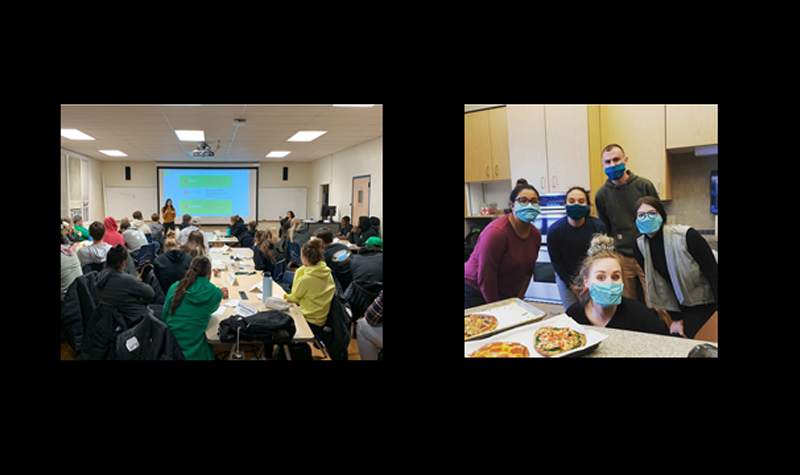
Success: Delivery of educational programs
I said earlier that a hallmark of the design of our prevention systems is to meet the students where they are. The feedback we’ve received on our prevention programs – delivered by our partners at CVIC – has been extraordinary. There is a true demand by our students for engagement, and they clearly spread the word.
In academic year 20-21, we:
• Reached over 3,000 students through presentations, booths and events.
• Had 45 trainings, booths, events and media contacts. This includes 20 classroom presentations. Fourteen of the classroom presentations were in Intro to University Life courses.
• 97 percent of attendees reported having an increased level of awareness of issues and campus resources.
When we talk about meeting the students where they are, these images truly capture that sense:
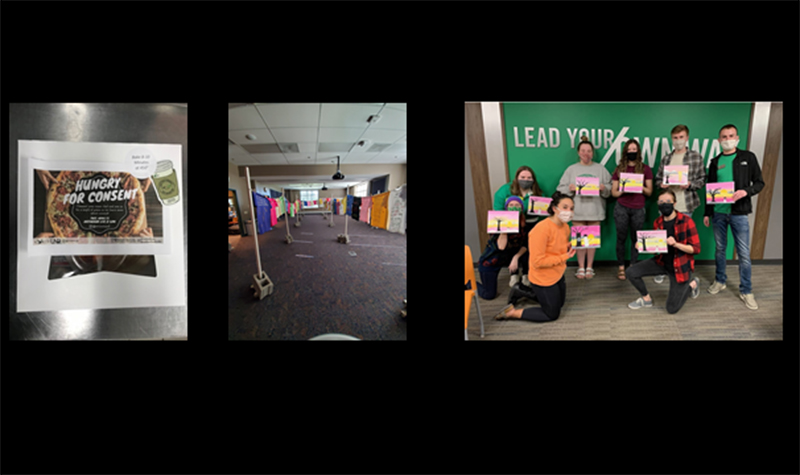 The Clothesline Project; Canvas and Cocoa (with a focus on bystander intervention; UNIV 101; Hungry for Consent (pizza as a metaphor – conversations about consent should be just as easy as ordering a pizza with friends!)
The Clothesline Project; Canvas and Cocoa (with a focus on bystander intervention; UNIV 101; Hungry for Consent (pizza as a metaphor – conversations about consent should be just as easy as ordering a pizza with friends!)
Last year during COVID, we kept the work going through virtual events such as “Take Back the Night” and the Clothesline Project.
Active engagement with Greek organizations and sports teams; long list of seminars, including topics like the following from our Healthy Relationship series:
• Love Labyrinth
• Behind the Post (social media)
• Escalation (based on a true story)
• Breaking up and Bouncing Back
And general sessions about sexual violence, workshops such as:
• I ask: a conversation about sexual assault
• Let’s chat: changing the culture around sexual violence
Our top three topics over the last few years have been:
• Healthy/unhealthy relationships
• Sexual assault prevention
• Bystander intervention
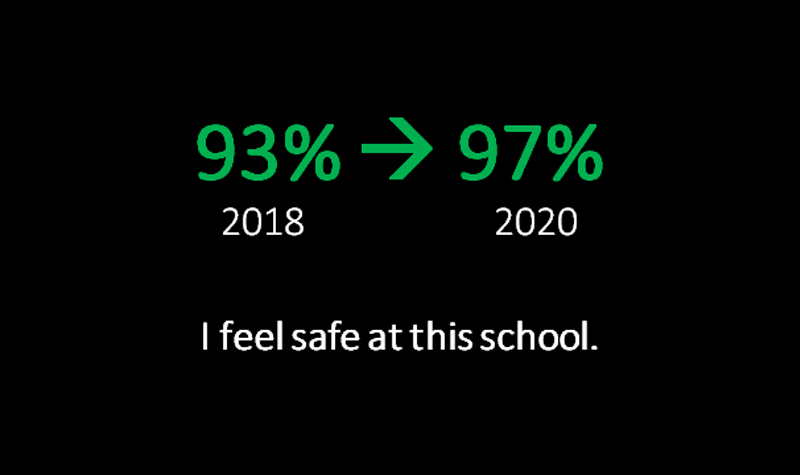
What the data tell us
And the data point in a positive direction, according to our student climate surveys. The general feeling of campus safety improved over the two offerings of the survey; the impressions of the school taking reports seriously also increased over that period; and the survey showed a slight decrease in incidence, though the 1 percent drop could be in the noise.
It is interesting to note that we had a 26 percent response rate in 2018, and a 42 percent response rate in 2020, which is a stunningly good response rate.
But how does this estimate of 6 percent incidence of sexual violence compare with the actual reports? In 2020-21, we had nearly three dozen incidents of sexual misconduct, including one rape.
It doesn’t take much math to determine that there is a gap between what has been reported in surveys versus the number of survivors coming forward to report. The discussions over the next two days will undoubtedly address ways to close this gap and to ensure those who need the support are getting it.
Final Thoughts
• Leaders must speak about these issues and offer assurance to victims of sexual violence that we wiIl help them heal, while at the same time providing an expedient and fair process. The changing landscape of Title IX, changing administrations and recent court cases make this tricky.
But messages from leadership about providing a campus environment rooted in respect and compassion are essential. I learned early that my voice was important, especially the more senior I became. I had Academy cadets come to me after I spoke at a “Take Back the Night” rally telling me of the impact of my words.
I have sought to do the same at UND, using my voice frequently in biweekly campus-wide videos to talk about an environment of respect and dignity, to talk about each person’s role in addressing sexual violence on campus, and to speak specifically to student groups about simple steps they can take to prevent the harm of others.
• Turnover in leadership can create gaps, and the professionals doing this work day-in and day-out must work with new leadership to craft the campus narrative. This must happen immediately.
• Our language matters, and we seem to chase our tails on our terminology. In the military, we used sexual assault as an umbrella term, even though legally sexual assault is a specific form of sexual violence. The result is confusion among our campuses and the general public about the scope of the problem when reporting results publicly.
We simply have to be more clear when communicating with the general public. When an “and” changes to an “or” in Title IX, we must adjust accordingly, and let survivors of sexual violence know that their healing is our top priority.
• We must pay close attention to Congressional leaders such as U.S. Sen. Mazie Hirono from Hawaii, with whom I interacted on the Air Force Academy Board of Visitors, and Rep. Jackie Speier from California, who has been dogged in her criticism of the services and academies. I was pleased to see their involvement in this National Discussion and know they will continue to challenge each of us.
• We must also focus our work on the needs of male victims.
• I fear that we will be at this a long time – likely forever. Yet, I’ve seen the great pros who are so committed to this cause, who have extraordinary endurance and compassion, and who will see to it that we make our campuses safer. Their work will ensure all our students have the chance to receive a great education without the fear of sexual violence or sexual harassment.
Contact information
Thank you for listening today. It’s a joy to be “back” at the Academy to share these perspectives. If you have any follow-up questions, please don’t hesitate to reach out through any of the methods you see on the board. Keep up your great work in creating the right culture on your campus, by creating the appropriate systems to ensure just processes, and by providing your support to survivors of sexual violence. Thank you!
